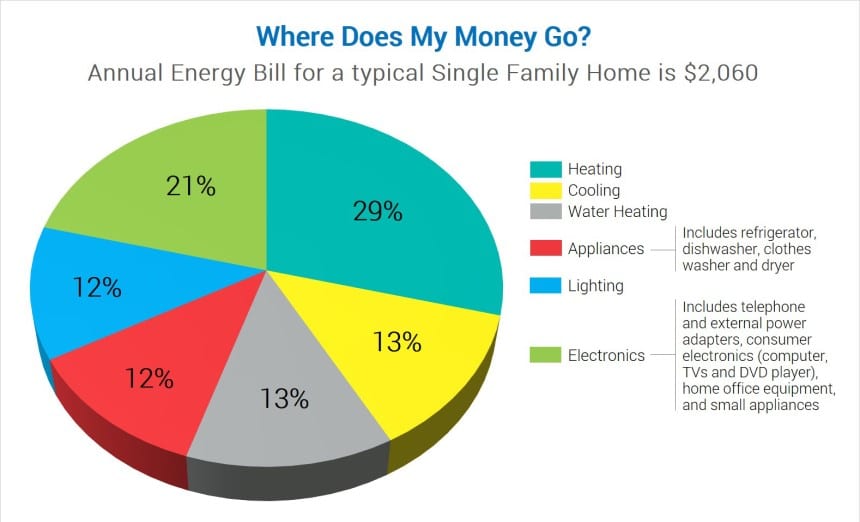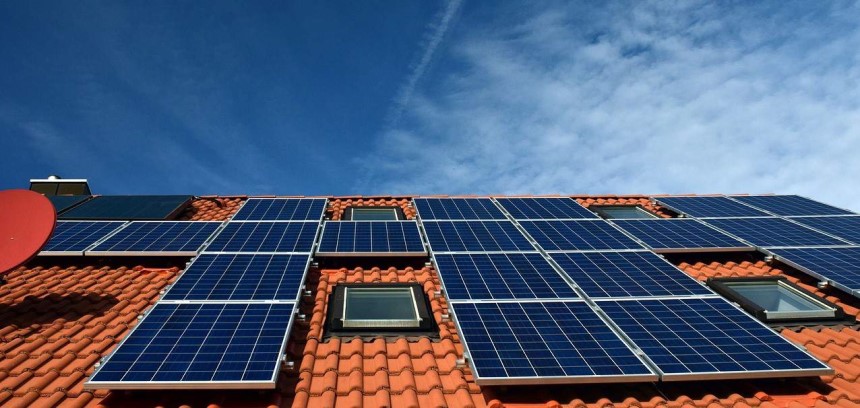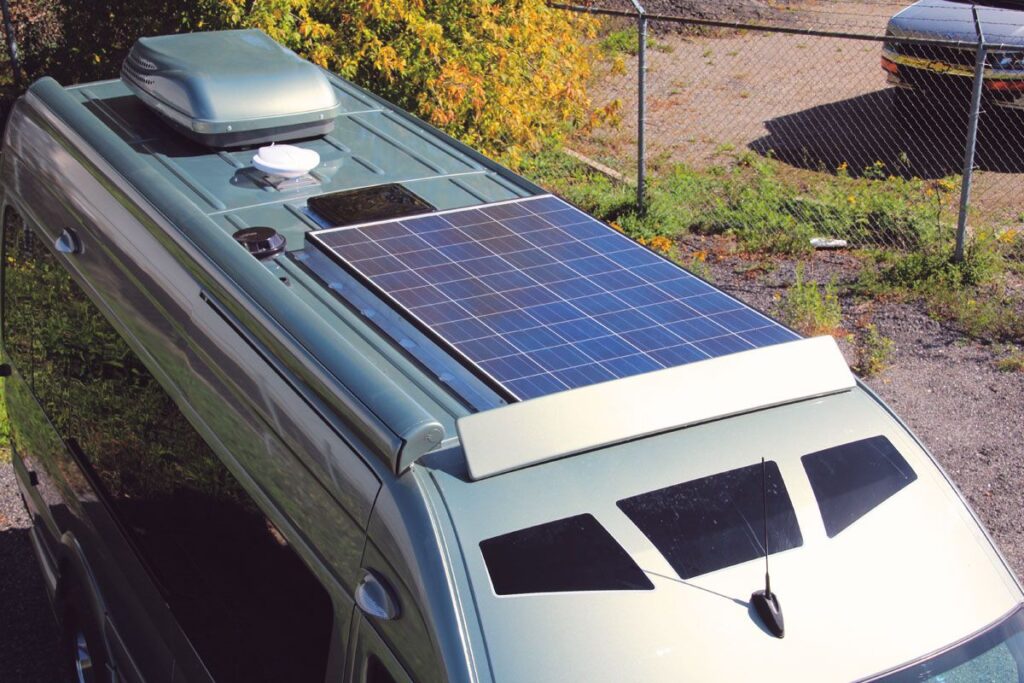Solar energy provides a neat solution for our growing energy needs. Today, the average American home needs 10,649 kWh annually, costing about $1,700. However, before you plug into the sun and save on energy costs, you’ve got to know just how many solar panels will be enough to power your home.
Initial calculations show that the average household in the US could use 28-42 solar panels to cover 100% of their annual energy bills. This number varies a lot because of factors such as differences in solar energy received in different places, efficiency of solar panels, and more.
Regardless of where you live, it is important to cover all of your current energy needs with solar panels so that you can maximize returns. The goal is to become a net-zero household, producing as much energy as you use. Clean energy is the most compelling reason to choose solar energy over a generator for off-grid living.

Go though your latest monthly bills and compare your usage for the last 12 months. This information will be in kilowatt hours, or KWh. One KWh is the average of 20 50-Watt bulbs staying on for one hour. Depending on what appliances you use, your annual consumption could be higher or lower.
Some of the biggest energy hogs in any home include HVAC (up to 1900kWh a month), refrigerators (162kWh a month), washer and dryer (91kWh a month), oven (75kWh), lighting (300kWh per month), and TV/media (55kWh).
Thus, a small home with minimal energy needs in a temperate climate could use as little as 200kWh each month, while a large one in tropical or subtropical climates could use 2000kWh or more. The US average is about 900kWh per month, which would translate to about 28 250-Watt panels.
But hold on, because calculating the right number of solar panels needed to power a house is not that easy because of differences in solar energy production.
The region you live in dictates how many hours of sunlight you can expect every day, as well as the maximum solar irradiation value expressed in kWh per square meter. A higher irradiance value means more energy falls on a unit area, which would increase the solar panel efficiency.
Thus, a house in California would need fewer panels to generate sufficient energy compared to a similar-sized household in New England. For easier comparison, you can use the average solar panel production ratio for your particular region.
The energy production ratio is the array’s estimated annual energy production divided by its rated capacity; this ratio should always be higher than 1:1. For example, a ratio of 1:61 (highest in the US) would mean a 6kW array will actually produce 9.6kWh.
A higher ratio means the panels achieve higher efficiency for your particular region, and thus fewer panels will be needed. You can find out your region’s energy production ratio from
EnergySage
Trusted Source
How Solar Installers Calculate Solar Production Estimates | EnergySage
Learn what a production estimate is and how your solar installer calculates it.
news.energysage.com
.
You can now find out exactly how many solar panels you need for your home. Divide your average annual consumption by the solar production ratio for your state, then divide that number with the wattage of the panels you will be installing.
For example, if your energy needs amount to 10,800kWh per year and you live in Utah, that could work out to something like:
10,800kWh / 1.4 / 250 = 31 panels.
Thus a 8kWh system would meet and slightly exceed your annual energy needs. This is good because in practice, you would want to add about 25% or wattage to act as a cushion in case of adverse weather conditions.
Remember also that your energy consumption is likely to rise, and the efficiency of solar panels tends to deteriorate with age at the rate of about 0.8% per year.
While these figures can seem frightening at first, it doesn’t have to be that bad. For minimalist living, a simple solar briefcase system such as the Renogy 100W portable and foldable solar system is perfect.
The Renogy foldable briefcase solar system is highly portable and can be easily set up at a campsite, on the roof of an RV, or wherever you need it. Users love the system for its ruggedness and ease of use, but there are also several other portable 100W solar panels you can choose from.
 Will Your Roof Take It?
Will Your Roof Take It?The estimated number of solar panels needed is only one side of the story. It is also important to determine how much roof space you have for your solar array. The average roof space required for 1 kW is about 100 square feet when you use standard residential solar panels.
If you have a lot of roof space available, you can get off with buying larger but less efficient modules, which can be significantly cheaper. However, if you have a small roof, then you might need to spend more money on more efficient modules.
Not all your roof area might be factored into this equation. Here in the US, a southern-facing roof free of shade and obstructions is the best place for solar panels. Side-ways facing roofs can also be used, but they will be less efficient and require more panels.
Conventional solar panels measure 65” x 39” or 5.4ft x 3.25ft. This gives them an area of 17.55 sq. ft. However, some large panels measure up to 20.83 sq. ft, but these are commonly used for commercial applications.
Depending on the shape and usable size of your roof, you may need larger panels with higher efficiency to help you achieve the same amount of energy production as a larger and more optimal roof.
Talking of efficiency, solar panels vary greatly depending on many factors such as quality of workmanship, materials used, and even temperature.
Solar panels are tested by the manufacturer at standard values of 250C. At or below this temperature, the efficiency remains near maximum depending on the solar irradiation levels. However, at higher temperatures, a drop in voltage and current results in a corresponding drop in efficiency.
The reason for this lies in the chemical structure of the photovoltaic cells responsible for converting sunlight to electricity. Here’s the short explanation: high temperatures mean that electrons have a higher resting energy, so less energy is required to knock them off. As a result, less energy is imparted to them and less electrical energy is produced.
For every 10C rise in the module’s surface temperature, you can expect a specific drop in efficiency known as the coefficient of Pmax temperature. This value is supplied by the manufacturer and can help you calculate operating efficiency.
We have already seen that the region in which you live affects the maximum solar irradiation that reaches your panels. The other factor lies in the angle of incidence at which sunlight strikes the surface.
Thus, the slope of your roof, your latitude, and season of the year all come into play to determine the best angle at which to install your solar panels. The technicians responsible for the installation will usually calculate all that for you.
Leaves, trees, adjacent buildings – these can cut your solar array’s efficiency by over 30%. The whole array needs to be clear of debris, leaves, dust, and anything else that could cause the whole array’s voltage to drop.
You may or may not know that if a whole array of solar panels is connected in series, it operates at the same level as the cell producing the least current. Thus, just one shaded cell brings down the operation of the whole unit.
With all the brands of solar panels currently available, it makes sense that solar panel efficiency varies greatly. Conventional modules have an average efficiency of about 14-18%, while the best solar panels can go as high as 22%.
One of the best solar panels we can recommend is the Renogy 600W 12V monocrystalline system. These solar panels are designed for residential and off-grid use, providing up to 21% efficiency and are optimized for easy setup. The system also comes with a charge controller.
A house with minimal energy usage would include a fridge, mini-split heating and cooling, lights, TV, laptop, and other negligible needs. That rounds off to about 4kWh a day or about 120kWh a month. This means that 15 conventional panels are more than enough to power a tiny house.
Living off-grid will require slightly more energy production as well as reliable storage. However, you might also need to have a backup generator just in case.
Renogy provides a solar sizing calculator Trusted Source Solar Cable Gauge Calculator Renogy US Solar brings 3 distinct solar panel calculators to help you estimate your power project requirements. www.renogy.com which you can use to determine your solar energy needs. From there, it’s only one step to finding out the exact number of solar panels needed depending on the estimated energy production capacity.
An average household measuring 1,500 square feet would need about 16 panels to cover solar energy needs. Again, this depends a lot on individual energy usage.
Since a 250W panel with 4 hours of sunlight would produce 100W a day, then 33 panels will give you 1,000kWh a month.
As you can see, calculating how many solar panels it takes to power a house is not exactly rocket science. It does, however, depend a lot on many factors that tend to vary from house to house. At the end of the day, it makes more sense to install the highest wattage solar energy system you can afford to achieve maximum returns.
If your state authorities have attractive incentives for going green and you’re willing to invest in solar energy, then there is very little to keep you from plugging into the sun. it doesn’t matter that you have long winters or fewer hours of sunshine because all you need to do is figure out how many solar panels will power your house effectively.





